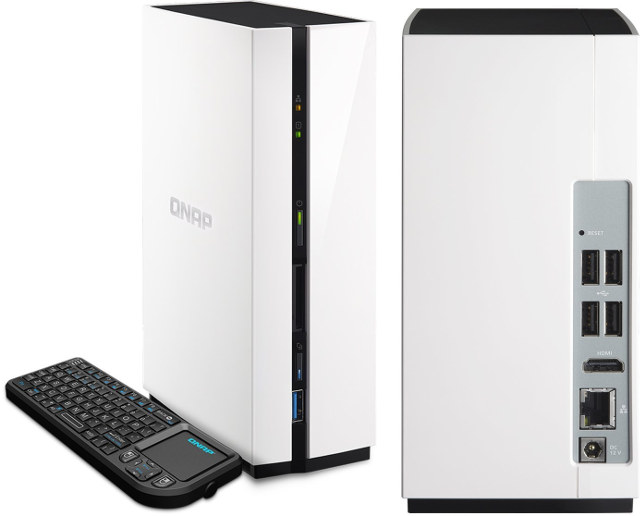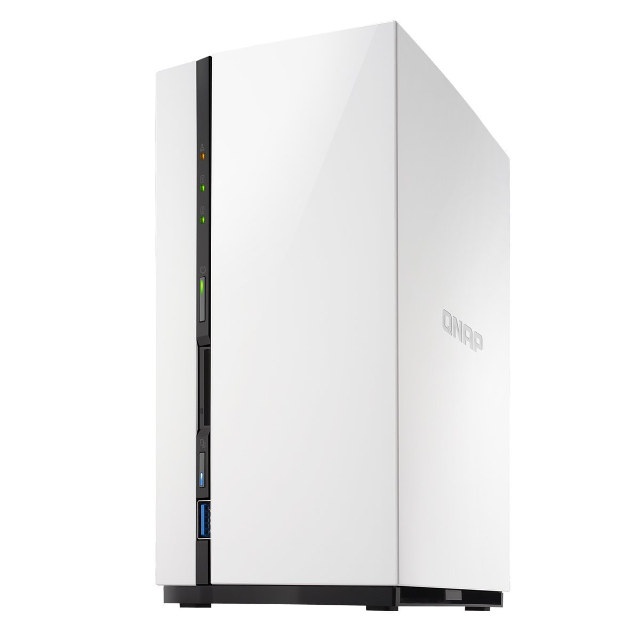QNAP has recently launched two network attached storage (NAS) devices with TAS-168 and TAS-268 that are based on Realtek RTD1195 dual core processor, and happen to run Android along side the company’s Linux based QTS operating system, and respectively have one and two bays for 2.5″ or 3.5″ hard drives.

QNAP TAS-168 and TAS-268 specifications:
- SoC – Realtek RTD1195 dual core ARM Cortex A7 processor @ 1.1 GHz with Mali-400MP2 GPU
- System Memory – 2 GB DDR3
- Storage
- 4 GB eMMC and SD card slot
- TAS-168 – 1x 2.5″ or 3.5″ SATA @ 3Gbs
- TAS-268 – 2x 2.5″ or 3.5″ SATA @ 3Gbs
- Video and Audio Output – HDMI port
- Connectivity – Gigabit Ethernet
- USB – 1x USB 3.0, 4x USB 2.0 host ports
- Misc – IR receiver, LEDs for HDD, LAN, status, and USB, buttons (Power, reset, USB copy)
- Power – TAS-168 – 12V/3A (36W) power adapter; TAS-268 – 12V/5A (60W) power adapter
- Power consumption
- TAS-168 – HDD sleep mode: 1.6W; Active typ. : N/A
- TAS-268 – HDD sleep mode: 5.4W; Active typ. : N/A
- Dimensions
- TAS-168 – 187.7 x 60 x 125 mm
- TAS-268 – 187.7 x 90 x 125 mm
- Weight – TAS-168 – 560 grams; TAS-268 – 700 grams

The internal hard drive will be formatted to EXT-4, while the USB interfaces support EXT-3, EXT-4, NTFS, FAT32 and HFS+ file systems. The performance is said to be 60MB/s and 80 MB/s for repetitively uploading and downloading files from a Windows machine. TAS-268 also support RAID-1, RAID-0, and JBOD configurations. You can find more details on QNAP product sheet.
I previously reviewed an RTD1195 TV box, and Gigabit performance with iperf was about 640 and 750 Mbps in dual duplex mode, and USB 3.0 read speed maxed out to 44.52 MB/s, both of which are pretty decent numbers for TV boxes, but possibly a little on the low side for a NAS. Performance of the system under Android was however sluggish, but the system only had 1GB RAM which would get apps quickly killed, and QNAP NAS should run a bit more smoothly thanks to 2GB RAM. However, the 4GB eMMC flash will quickly fill up if you start installing apps. I could not find reviews yet, but this quick installation guide will show you what you can expect to receive and how to setup the NAS.
Both NAS sells on Amazon US with TAS-168 and TAS-268 going for respectively $199.99 and $249.99 without hard drives. A few more details may also be found in QNAP Android NAS page.
Thanks to Gabe for the tip!

Jean-Luc started CNX Software in 2010 as a part-time endeavor, before quitting his job as a software engineering manager, and starting to write daily news, and reviews full time later in 2011.
Support CNX Software! Donate via cryptocurrencies, become a Patron on Patreon, or purchase goods on Amazon or Aliexpress





Along the same lines can anyone recommend a NAS box for one or two drives that is more moderately priced and will run freeNAS?
@Eamonn
HP Microserver Gen8
Build your own using mini-ITX, or if you can live with a single 2.5″ HDD, an Intel NUC.
BTW, FreeNAS’s recommendations are pretty high.
I highly recommend NAS4Free or FreeNAS with ZFS because of ZFS’s superior data integrity.
@TonyT
But if you have ‘data integrity’ in mind you should also choose ECC RAM. If you don’t do deduplication then 4 GB might be already fine. And btrfs is a nice alternative in the meantime (also easy to use through eg. http://rockstor.com/features.html)
Aside from the NUC suggestion I think those are all too big for my needs. I was hoping for something around the size of a WD mybook but powered by an intel chip rather than arm/mips (I don’t think freenas has mature support for arm yet). Maybe nas4free would be a better solution, but again its intel only for mature codebase atm. I’ll look in to it. I don’t need anything great, it’s really just for storing media and data loss isn’t the end of the world, but it would be nice to just ‘set it and forget it’ rather… Read more »
You could always get a pogoplug install arch and any external drive you want. Or just use the pogoplug itself. Arch site below show how to install but be careful to follow the guide for the right pogoplug.
http://archlinuxarm.org/platforms/armv5/pogoplug-v2-pinkgray
@Eamonn
If you want something inexpensive and hackable (runs Debian), you could use Zyxel NAS310 or NSA320 http://www.cnx-software.com/2013/07/09/zyxel-nsa310-nsa320-hackable-network-access-storages-run-debian-linux/
No FreeNAS support however.
I’ve just checked the recommended hardware: FreeNAS Mini, and I understand why you are looking for an alternative… 🙂
@Jean-Luc Aufranc (CNXSoft)
If none or a DIY enclosure is also ok then currently the pcDuino3 Nano Lite is a good choice for $15: http://www.amazon.com/pcDuino-pcDuino3-Nano-Lite/dp/B00ZEPZGQO
Performance as with most A20 SoCs that have both SATA and GBit Ethernet — using mainline kernel you’re able to exceed 40MB/s in both directions: http://linux-sunxi.org/Sunxi_devices_as_NAS
And fully supported by Armbian: http://www.armbian.com/pcduino3/ (better than ‘plain Debian’)
Some further comments: — If you don’t need the extra data integrity, then a commercial, compact 1 or 2 bay NAS (e.g. NS310/320 mentioned above) is a better fit than a NUC/mini-ITX. — There is debate over the value of ECC memory. When I re-do my “main” NAS (on 24×7), I’ll probably add it, but for an idea of the debate, check out http://blog.codinghorror.com/to-ecc-or-not-to-ecc/ — I thought about btrfs vs zfs, but went with ZFS. For one, ZFS is still more mature. Your judgement might be different. — One annoying thing about most super-compact cases is that they require an… Read more »
@TonyT Regarding ECC or not you should better read in the comments: http://discourse.codinghorror.com/t/to-ecc-or-not-to-ecc/3771/18 It’s really that simple: If you can’t trust the contents of DRAM, bit rotting *will* occur. So if you love your data, choose RAM that uses advanced ECC techniques (and not simple ones as we’ll see even with LPDDR4 on mobile devices next — they added this for a reason 😉 ) We’re running servers that survived 72 hours burn-in memtest without a single error (not even corrected single bit flips in the EDAC logs) and show single bit errors from time to time in production. If… Read more »
@tkaiser
Thanks for the comments. If a system is on 24×7, I think ECC makes a lot more sense.
A NAS by itself is not backup – one of the nice features in FreeNAS is supposedly easy sync between FreeNAS servers so you can have backup by using multiple NAS units.
while SATA is great, I think it’s fine to hook one or two portable 2.5″ USB hard drives directly to many boards for a decent NAS, they can even be powered via usb directly. After USB3 is out it’s even better, how better is SATA’s performance comparing to USB these days?
@xxiao
USB performance varies a lot between device and file systems.
if you look at the chart below it varies between 15MB/s to 100 MB/s read speeds
http://www.cnx-software.com/wp-content/uploads/2015/10/Zidoo_X6_Pro_USB_Mass_Storage_Performance.png
SATA is not so common, but did test it on CubieTruck up to 180MB/s (with a different banchmark) -> http://www.cnx-software.com/2014/12/21/cubietruck-metal-case-kit-getting-started-guide-and-review/
is there any video surveillance application in Qmarket that I can use similar to a Synology DSM video surveillance? Integration with third party cameras would be great
@TonyT ECC is a simple requirement if you want to avoid bit rotting. Combined with a decent filesystem that implements end-to-end data integrity like ZFS, btrfs or ReFS. That’s the reason we always recommend HP Microservers (since that’s the cheapest way to get a few HDD bays combined with a CPU that is able to do hardware accelerated encryption — AES-NI — and ECC-RAM). On these Microservers you can run FreeNAS, Solaris x86, Linux, ESXi or even Synology’s DSM (maybe also Windows — no idea since who needs that?). When you still love ‘bit rotting’ (and refuse to accept the… Read more »
is there any video surveillance application in Qmarket that I can use similar to a Synology DSM video surveillance? Integration with third party cameras? I also would like to know this answer.